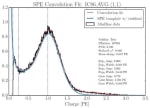Fast radio bursts (FRBs) are some of the most enigmatic phenomena in the universe. These millisecond-long pulses of radio waves most likely originate outside of our galaxy, but we don’t know much more than that. The IceCube Collaboration recently looked for neutrino events that coincided with 28 nonrepeating FRBs and one repeating FRB. Searching for neutrinos emitted from the same part of the sky as FRBs could provide clues to help test models that suggest particle acceleration near the FRB source. Results from this search are outlined in a paper published today in The Astrophysical Journal. […]
Research
New insights into the astrophysical neutrino flux
In a paper recently submitted to Physical Review Letters, the IceCube Collaboration presents new results of an analysis to determine and characterize, with unprecedented precision and across the entire sky, the combined flux of astrophysical electron and tau neutrinos. […]
New optical telescope proves to be fit for the South Pole
For South Pole experiments like the IceCube Neutrino Observatory, all instruments—whether in the ice or on the surface—must undergo feasibility studies to make sure they can operate in the harsh Antarctic conditions. Optical instruments, especially, are subject to icing and snow accumulation. Recently, the IceCube Collaboration proved the successful operation of a new instrument, an imaging air-Cherenkov telescope, at the Pole. They outline the details of the study in a paper published today in the Journal of Instrumentation. […]
Optimizing the “eyeballs” of the IceCube Neutrino Observatory
Researchers in the IceCube Collaboration are always looking for ways to improve the understanding of the PMTs so they can get the highest-quality data from the DOMs. Most recently, they implemented a new method for more accurately characterizing individual PMT charge distributions, which was shown to improve PMT calibration and simulation. The method is described in a technical report submitted today to the Journal of Instrumentation. […]
IceCube performs the first-ever search for neutrinos from the sun’s atmosphere
The IceCube Collaboration recently performed the first-ever experimental search for solar atmospheric neutrinos. Such a detection would have important implications for understanding solar magnetic fields and how cosmic rays propagate in the inner solar system, and it could even provide additional background to solar dark matter searches. But after investigating seven years of IceCube data, IceCube researchers did not detect any solar atmospheric neutrinos and so set an upper limit on the flux. Their results are outlined in a paper that was recently submitted to the Journal of Cosmology and Astroparticle Physics. […]
ANTARES and IceCube combine forces to search for southern sky neutrino sources
The IceCube Collaboration recently conducted a combined IceCube-ANTARES search for neutrino point-like and extended sources in the southern sky. They didn’t find any significant evidence for cosmic neutrino sources, but the analysis shows the strong potential for combining data sets from both experiments. Their results were submitted to The Astrophysical Journal. […]
IceCube rules out last Standard Model explanation of ANITA’s anomalous neutrino events
IceCube isn’t the only neutrino experiment in Antarctica. There is also the ANITA (the ANtarctic Impulsive Transient Antenna) experiment, which flies a balloon over the continent and points radio antennae toward the ground in search of extremely high-energy neutrinos.
The IceCube Collaboration recently followed up on events detected by ANITA and presented their results in a paper submitted today to The Astrophysical Journal. The collaboration found that these neutrinos could not have come from an intense point source. Other explanations for the anomalous signals—possibly involving exotic physics—need to be considered. […]
Locally sourced neutrinos? IceCube takes a look
IceCube has not yet found neutrino sources within our galaxy, but there may be sources that are not too much farther out. To test this possibility, the IceCube Collaboration recently performed an analysis scouring the local universe for potential neutrino sources. They conducted two different searches that looked for correlations between neutrino emission and dense regions in a catalog of galaxies called the 2MASS Redshift Survey (2MRS). While they did not find significant sources, they were able to put constraints on neutrino emission from nearby galaxies, which they present in a paper recently submitted to the Journal of Cosmology and Astroparticle Physics. […]
Putting neutrino masses in their place (soon!) with the IceCube Upgrade and JUNO
Neutrino mass ordering is one of the foremost problems in neutrino physics today. But two new neutrino oscillation experiments are on the horizon—the IceCube Upgrade and JUNO. So the IceCube Collaboration and the JUNO Collaboration studied the combined performance of their respective experiments, which employ very distinct and complementary routes in order to resolve the neutrino mass ordering. In a paper submitted recently to Physical Review D, they show that a combined analysis could eliminate the wrong mass ordering in as few as three years from the start of data taking. […]
What can cascade events tell us about neutrino sources?
Cascade events are more difficult to reconstruct than tracks, which are usually used in searches for astrophysical neutrino sources, but cascades have their own advantages, including providing a better measurement of neutrino energy. In a paper published in The Astrophysical Journal, the IceCube Collaboration outlined recent results from a source search that used seven years of data from cascade events. While they did not find any statistically significant sources of neutrino emissions, this work is an improvement on the previous source search with cascades. […]









